Menu

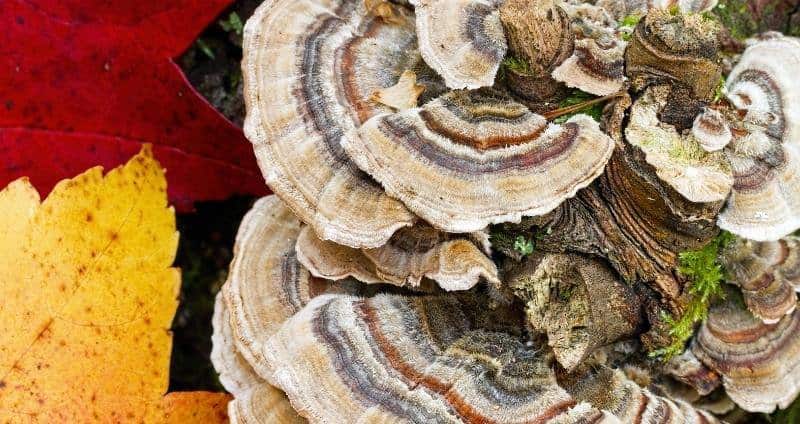
Turkey tail mushrooms are among the primary saprophytes (fungi that grow on dead matter) that attack and decompose rotting wood. It’s, therefore, no wonder that these polypore mushrooms are most commonly found on fallen logs or tree stumps.
Though these mushrooms (fruiting bodies) can also be found on living trees, they mostly grow among other mushroom saprophytes, such as the false turkey tail fungus. For this reason, you need to learn how to correctly identify turkey tail mushrooms and avoid look-alikes.
Fortunately, turkey tail mushrooms do not have toxic look-alikes, which generally makes them a “safe” mushroom to forage.
Similar mushrooms, however, lack the health-supporting compounds that these functional mushrooms are known and valued for.
To help you correctly identify the true turkey tail, and to give you some helpful facts about this mushroom and its uses, we’ll answer these 11 questions:
We’ll also discuss some ways to consume turkey tail, including which way is best for getting maximum potency from it. Let’s first identify the most common look-alikes.
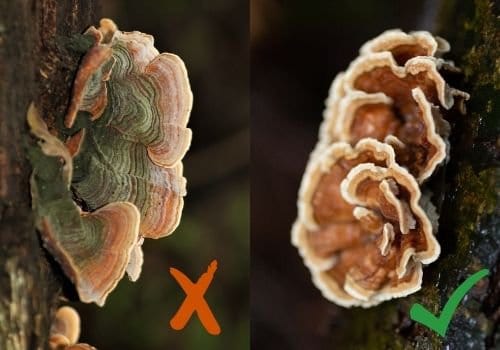
False turkey tail mushrooms, scientifically known as Stereum ostrea, are most commonly misidentified as turkey tail.
Like the true turkey tail mushrooms (scientifically known as Trametes versicolor), false turkey tail mushrooms also grow on stumps and fallen logs of deciduous trees.
Some other similar features it has to the “true” turkey tail:
The table below highlights the key differences between turkey tail and Stereum ostrea, a common type of false turkey tail.
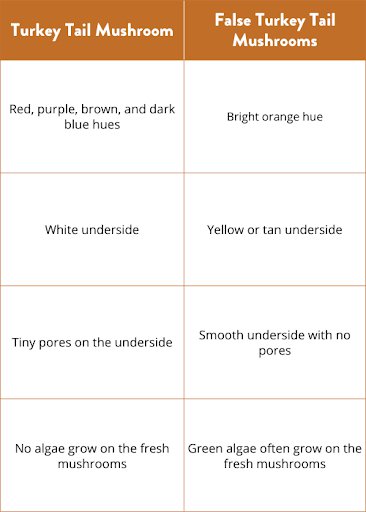
Generally, turkey tail mushrooms don’t have a gill-like underside. Real turkey tail mushrooms have visible pores on the bottom, while false turkey tail mushrooms have a smooth underside.
The key identification feature of the false turkey tail fungus is its underside. Being a crust fungus, it has a smooth underside, unlike Trametes versicolor (the scientific name for turkey tail mushroom), which has pores.
The underside is also yellow or tan, unlike the true turkey tail, which has a white underside.
Another identifying feature is its growth. Stereum ostrea often curves upwards to the edges, while the turkey tail often has plane growth.
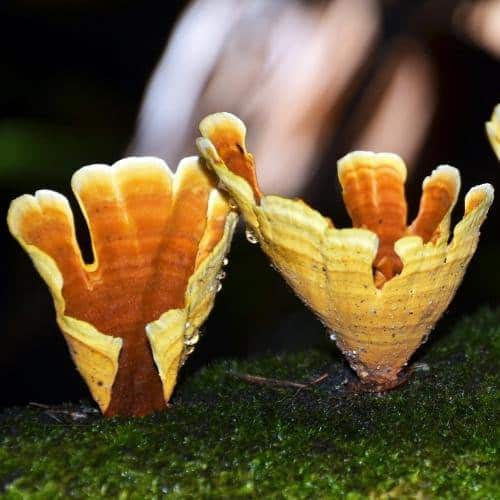
Turkey tail mushrooms have a wide range of colors, from red and brown to dark blue and purple hues, which makes them easy to misidentify.
The following six-step process will, however, ensure you correctly ID a true turkey tail mushroom:
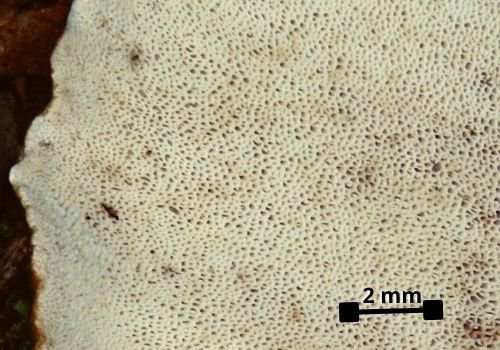
There are two more species that are also misidentified as turkey tail mushrooms:
As you can probably tell from their names, both species are also polypores, like the real turkey tail. They also have concentric growth rings on the cap with an irregular outer margin.
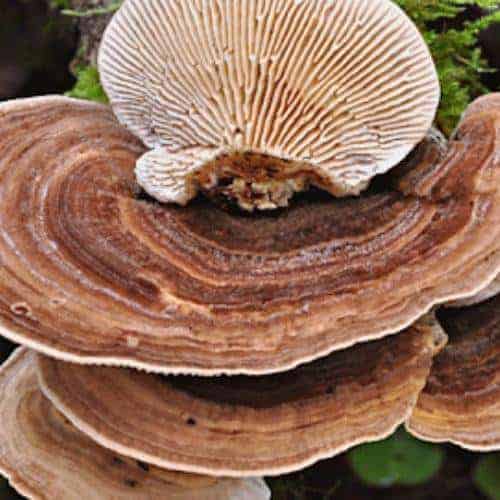
The table below highlights the key differences between turkey tail, violet-toothed polypore, and gilled polypore mushrooms.
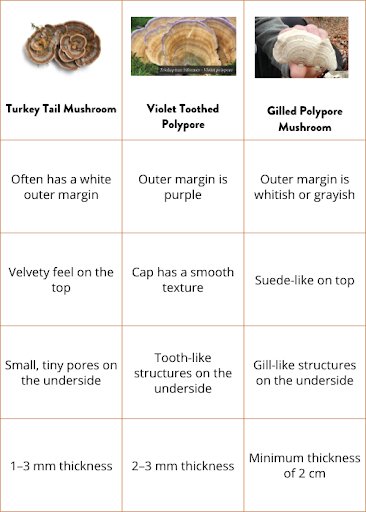
The key differentiating factors between these wild mushrooms include the color, underside appearance, and thickness. While real turkey tail mushrooms have visible pores, violet-toothed mushrooms have tooth-like structures, and gilled polypore mushrooms have a gill-like underside.
Fortunately, as we mentioned before, none of the Trametes versicolor look-alikes are poisonous. But do they have any health benefits when consumed?
One study has identified Stereum ostrea as having antibacterial and antifungal activity against specific agents. The study highlights that this fungus “has long been used for folk remedies even without any knowledge of which compounds are responsible. The ethnobotanical uses of this mushroom to help manage both human and plant disorders have been accumulated, but scientific evidence is not yet well known” (1).
Trametes betulina (gilled polypore) is from the same family as turkey tail—hence the similar first name. It shares some antioxidant properties in common with the Trametes group (2). However, it falls short (in health benefits) since it doesn’t have as rich or diverse a composition of health-supporting compounds as a true turkey tail.
Research on the turkey-tail lookalikes is still limited. True turkey tail, on the other hand, is one of the most studied mushrooms in the scientific world, so we can be more certain of its health-supporting properties.

Turkey tail mushrooms contain polysaccharopeptide and polysaccharide-K, which have many health benefits, including:
Learn more about the turkey tail’s health-supporting compounds and health benefits here.
Yes, you can.
Tea is actually the most common way foragers consume wild turkey tail mushrooms. Hot water will help break down some of the polysaccharides in the mushrooms, so your body can absorb and benefit from them.
Here’s a step-by-step guide to help you make turkey tail tea after foraging for them.
Though some foragers also like to make tea from the false turkey tail fungus, there aren't any sources that can corroborate whether its tea has any actual beneficial effects on the body.
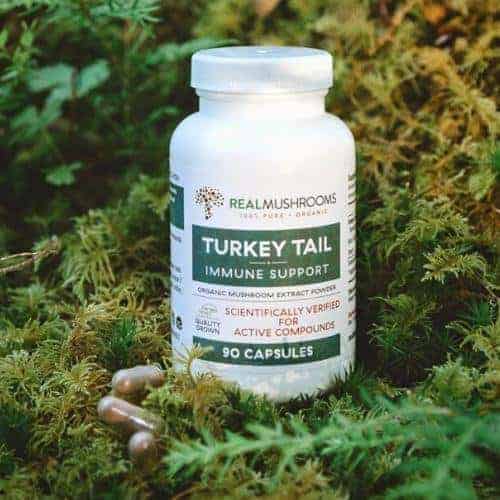
The best way to get a concentrated dose of all the beneficial compounds in turkey tail is through turkey tail extracts in supplement form.
It’s easy and convenient, and you don’t have to go through the whole process of identifying the true turkey tail from wild mushrooms.
You, however, need to ensure you identify the best turkey tail mushroom supplements, which will be:
Real Mushrooms’ Turkey Tail Extracts are extracted from mushrooms (fruiting bodies) using the hot water extraction method, which draws out most of the health-supporting compounds.
They also have a beta-glucan content greater than 30%, the highest in the market. Beta-glucans are powerful polysaccharides responsible for most of the turkey tail mushroom’s health benefits.
Yes, you can.
Turkey tail and reishi mushrooms individually have unique health benefits. Combining them will ensure your body gets a wide range of benefits synergistically.
Some other mushroom supplements you can combine with turkey tail:
You, however, need to ensure you take the recommended dosage of 1–3 grams daily when combining the mushroom supplements.
Real Mushrooms has the 5 Defenders Organic Mushroom Blend Capsules, which combine organic extracts from the following mushrooms:
“... I like the specific mushrooms selected for this capsule as they are each powerhouses in their own right.” Jane
Expert Tip: You can also make tea from a combination of functional mushrooms that you forage for. It’s easy: All you have to do is follow this guide and mix a handful of mushrooms instead of using one.

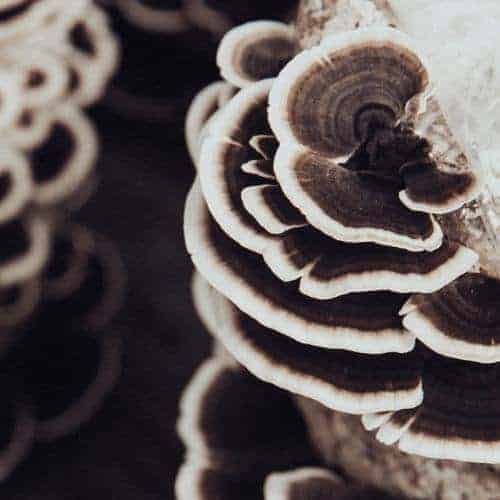
Real Mushrooms has a line of mushroom supplements extracted from the actual mushroom (fruiting body). This ensures that you get all the unique benefits of functional fungi without the starch found in supplements made from the fungal mycelium grown on grain.
As with all our mushroom supplements, our turkey tail extracts are organic, vegan, gluten-free, and non-GMO. They’re also available in powder and capsule form.
Order our turkey tail extracts to help your body boost its immune function.
“These mushroom supplements are contributing to my husband's and my health. I truly believe that the Turkey Tail, in particular, has been critical to our immune system.” Mary Rose
Disclaimer: The information or products mentioned in this article are provided as information resources only, and are not to be used or relied on to diagnose, treat, cure, or prevent any disease. This information does not create any patient-doctor relationship, and should not be used as a substitute for professional diagnosis and treatment. The information is intended for health care professionals only. The statements made in this article have not been evaluated by the Food and Drug Administration. Any products mentioned are not intended to diagnose, treat, cure, or prevent any disease. The information in this article is intended for educational purposes. The information is not intended to replace medical advice offered by licensed medical physicians. Please consult your doctor or health practitioner for any medical advice.